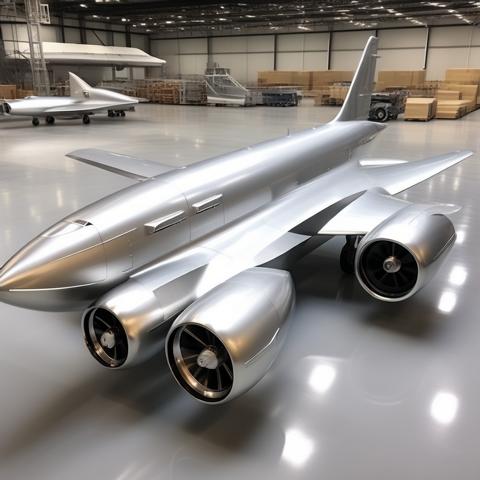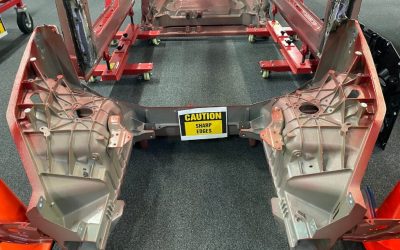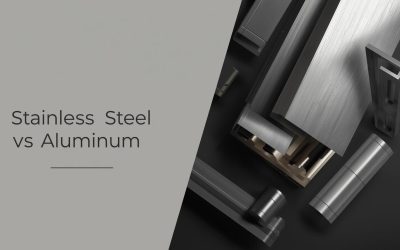Aircraft grade aluminum
Aluminum alloys are important in nearly all modern industrial innovations and production processes. These alloys are readily accessible and have a big range of uses because each contains a blend of two or more metallic elements providing them refined material properties.
The 6061 aluminum alloy is a largely used grade for various industrial applications. The alloying elements in the 6061 aluminum alloy provide special features, including remarkable strength, workability, electrical conductivity, corrosion resistance, and thermal conductivity.
Common names for 6061 aluminum alloy
The typical trade names of the 6061 aluminum alloy include:
- 6061-O
- 6061-T651
- Aircraft grade aluminum 6061-t6
- Alloy 61s
- 6061-Ta4
Aircraft grade aluminum 6061 benefits
With a number of beneficial features, aluminum is an easy choice for manufacturing aircraft. Wood was actually used to build aircraft, but it is prone to rot and can splinter without right maintenance.
Likewise, steel is more powerful than aluminum, but weighs significantly more. Steel is just used in aircraft when very high strength is required, such as landing gears, or very high-speed planes.
Strength of 6061 air-craft grade aluminum
One of the important benefits of 6061 air-craft aluminum is its commendable strength. Its tensile strength ranges from 124-290 MPa (18-42 ksi), which is similar to many structural applications. Anyway, it is vital to note that while 6061 aluminum is more powerful than some types of steel; it may not be as powerful as high-strength, low-alloy (HSLA) steel or different tool steels.
Corrosion resistance
When matching 6061 aluminum with steel, corrosion resistance is a vital factor to consider. Aluminum naturally forms a protective oxide layer when naked to air, providing amazing resistance against corrosion. On the other hand, steel is prone to rusting when not rightly protected. This is why aluminum is generally favored in open-air and marine applications where corrosion can be an important concern. The superior corrosion resistance of 6061 aluminum makes it a best choice for various atmospheres.
Weight of 6061 aircraft aluminum
In addition to its strength, another vital benefit of 6061 aluminum is its lower density matched to steel. Aluminum has a density of approximately 2.7g/cm3, which is about 1/3 density of steel (7.85 g/cm 3). This lower density provides 6061 aluminum, an important weight benefit over steel, making it a perfect choice for applications where weight reduction is important. For example, in the automotive industries and aerospace, where fuel efficiency and full weight are important factors, 6061 aluminum is generally preferred.
Applications of 6061 Aluminum Alloy
The 6061 aluminum alloy has many uses in many industries due to its amazing strength, lightweight, affordability, and resistance to rust. Aside from making aluminum cans, bicycle frames, industrial parts, electrical fittings, and food containers, here are other applications of 6061 alloy:
Aircraft components
Aircraft grade aluminum 6061 is one the most used materials in aerospace applications because of its amazing strength-to-weight ratio and top corrosion resistance. Manufactures generally use 6061 alloys to create aircraft components such as stabilizers, fuselages, bulkheads, wings and other structural components for military or commercial aircraft. The durability and flexibility of this alloy make it the best choice for applications with top demand.
Automotive parts
The 6061 aluminum alloy is used in the automotive sector to make many parts. This alloy has amazing strength for making frame components, such as vehicle, engine, suspension, brake, and drivetrain components.
Likewise, its lightweight attributes render it a perfect material for body panels. It helps to decrease the vehicle’s full weight without compromising its strength and durability.
Sporting goods
The sporting sector advantages from amazing corrosion resistance attributes and the strength-to-weight ratio of the 6061 aluminum. Manufacturers and product designers generally use this alloy to generate sporting goods like baseball bats, skateboards decks, golf club shafts, hockey stick holds, and tennis racquet handles. The flexibility of the 6061 alloy renders it a perfect material for this application.
What is the operating temperature range?
The operating temperature range of a particular alloy explains its warm aging, working, and annealing temperature range. The perfect warm working temperature for aluminum 6061 falls within the range 260-372 ºC.
Also, you can anneal the aluminum 6061 at 413 C for approximately 2-3 hours. Then, you can chill the metal at a controlled temperature of 10 C hours until it reaches 260 C. Furthermore, 6061 aluminum aging is best done at 160 C for precisely eight hours before chilling the air.
Is it wieldable?
The 6061 aluminum is very weldabe. You can weld it routinely using the right filler material. This filler material helps to stop all welding complexities involved in 6061 aluminum-solidification cracking. To get the top result from welding 6061 aluminum, you must utilize the best filler materials, which contains 4043 or 5356 aluminum alloy.
More vitally, it is advisable never to use 6061 filler material to weld aluminum alloy 6061 to stop cracking.
Aircraft grade aluminum 6061 manufacturing process
A high-strength material known as aircraft grade aluminum 6061 is generally used to make parts for airplanes. It is generally used to make airplanes because it is simple to weld, does not rust, and is powerful for its weight. It is very best to use aircraft grade aluminum 6061.
Bauxite ore, which is the key source of aluminum, is taken out of the ground when airplane 6061 grade aluminum is made. Before being warmed in an electrolytic cell to turn into liquid aluminum, the bauxite ore goes via a number of chemical processes to remove any impurities. Ingots or billets are cast from this molten metal to make 6061 aircraft grade aluminum.
Getting the metal billets or ingots is the primary step in a long process that ends when the finished item. Homogenization is the primary step in the manufacturing process. It involves warming the metal to a controlled temperature to ensure that its chemical makeup stays the same. This must be performed in order to get the mechanical features you want in the end result.
After homogenization comes warm rolling, this involves running the metal billets or ingots via a set of rollers to make them powerful while also making them thinner. The grain structure of aluminum during the warm rolling process, which makes it powerful and harder.
After being warm rolled to the right thickness, aluminum goes via a solution warm process. For this process to work, the metal has to be warmed up very high for a long time so that any alloying parts can be broken down. This makes aluminum that is powerful and more flexible, which are both best traits for airplane parts.
It is quenched in either air or water after solution warm treatment to cool it immediately while keeping its texture. Aluminum gets excellent mechanical features and performance after this treatment, which makes it remarkable for use in aircraft.
The final step in making air-craft grade 6061 aluminum is to age it artificially. To perform this, the aluminum has to be warmed to a certain temperature for a certain amount of time. This makes the alloying elements settle out, which makes the metal even harder and powerful. This process ensures that the aluminum meets the strict needs of the aircraft industry and helps the end item have the mechanical features that are wanted.
Comparing aircraft grade aluminum 6061 to other alloys
The 6061 alloy is one of the most general for extrusion, but you may be considering other choices for your particular application. Below are some other general alloys that are generally considered as alternatives.
6061 Vs 6063
6061 and 6063 are two most famous extrusion alloys. 6063 aluminum occupies the number 1 place and 6061 occupies number 2 place. As alloys in the 6000 series, they both have silicon and magnesium as their primarily alloying elements. Thus, they have lots of similar features, 6061 provides higher strength, anyway. As such, it is generally used for more structural applications. On the other hand 6063, is used for applications such as windows, trim or railing, and doors, due to its better look and corrosion resistance.
6061 Vs. 7075
One of the important reasons to consider 7075 aluminum alloy is for its high power. Alloyed with zinc, it is one of the most accessible alloys and more powerful than 6061. But it provides a lower level of corrosion resistance than 6061 and is also harder to weld. 7075 is used in marine, aerospace applications, and automotive where strength is an extreme priority. It is also used in firearms manufacturing and is even used in hang glider frames.
6061 Vs 5052
Like 6061, 5052 aluminum has magnesium as an initial alloy element. In the case of 5052, it is the primary alloy element. 6061 has silicon as well. One of the important advantages of this alloy is its high level of weldability matched to other alloys. For projects where weldability is key, it is worth considering. One downside to 5052, though, is that it is not heat treatable. It is best for a range of welding applications and it works well in marine applications due to its top corrosion resistance.
6061 Vs 2024
Initially used in aerospace applications, the 2024 alloy is famous for high strength. Its key alloying element is copper, and although it is powerful and has best fatigue resistance, it is less machinable and hard to weld than 6061. It also provides bad corrosion resistance and is generally used in wing and fuselage structures which come under top tension.
Challenges and limitations
A lot of planes are made from 6061 aircraft grade metal because it is powerful for its weight, easy to shape, and does not rust. Manufacturers and engineers must plan and build aircraft with its limits in mind, just like they would with any other material.
Many times, military grade 6061 aluminum has issues like stress corrosion cracks. When you put something in the ocean or acidic solution, or anywhere else that is corrosive, it can cause this kind of corrosion. There is a chance that little cracks could emerge in the plane’s structure, which makes it less stable. The risk can be lowered by doing regular checks and upkeep. This will help find the fix cracks before they get bad.
Aluminum 6061 does not have nearly as much stress strength as alloys and titanium. Steel and titanium are better at withstanding heat than aluminum 6061. This could make it difficult to use heat-sensitive materials in engine parts and quick planes, among other things. Some metal 6061 parts may need unique coating or thermal shields to keep from getting destroyed by heat and to make them last longer.
When put under a lot of stress, aluminum 6061 breaks down quicker because it is not as powerful as other aircraft metals. This could make the parts wear out quicker, which would mean they need to be serviced most generally. When engineers pick 6061 aluminum for use in airplanes, they need to think about what the material is meant to do and how it might wear over time.
FAQs
Is 6061 aluminum more powerful than steel?
6061 aluminum is powerful, but it may not be as powerful as certain kinds of steel, such as low-alloy steels, high strength or tool steels.
What is the weight benefit of 6061 aircraft grade aluminum over steel?
6061 aluminum has a significantly lower density matched to steel, which provides it a weight benefit. Aluminum has a density of about 2.7g/cm3, while steel has density of approximately 7.85 g/cm3.
What factors should be considered when picking between steel and 6061 aluminum?
When picking between aluminum 6061 and steel, it is vital to consider the specific needs of the applications. Factors to consider include weight, strength, and corrosion resistance.
How does corrosion resistance match between 6061 aluminum and steel?
Aluminum naturally creates a protective oxide layer, providing best resistance against corrosion. On the other hand, steel is prone to rusting and needs extra protective measures to stop corrosion.








0 Comments